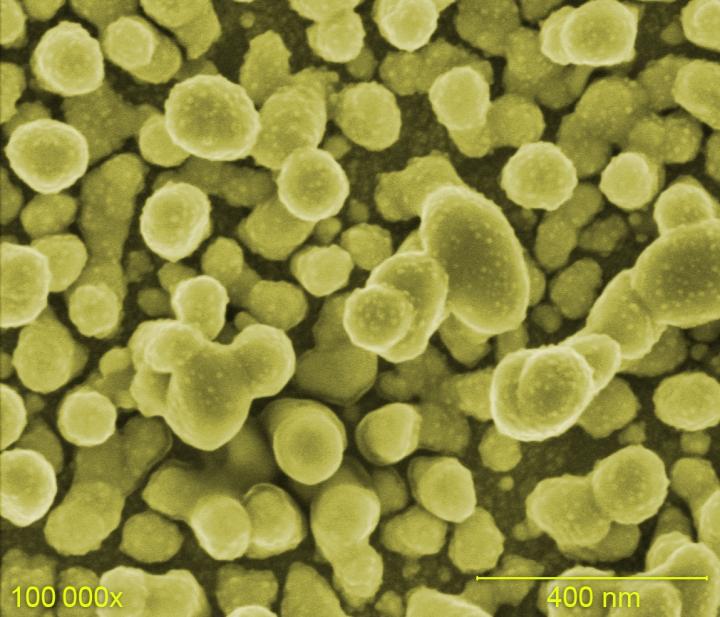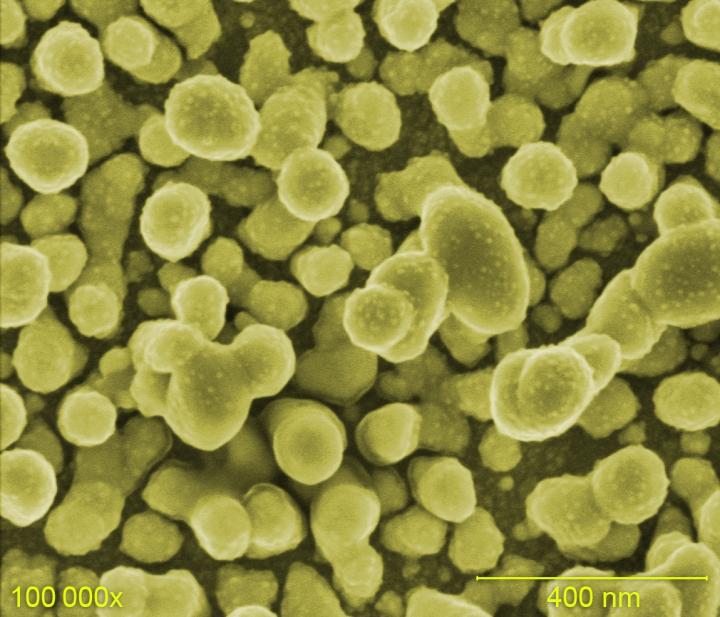
Credit: IPC PAS
SERS, an extremely sensitive laboratory method of analysing chemical composition, is set to become widespread decades after its invention. The main obstacle that has been slowing down the development of this promising research technique, the poor quality of the substrate on which samples are applied, is now disappearing. New substrates, guaranteeing repeatability of measurements and the appropriate signal enhancement, are now available thanks to scientists from the Institute of Physical Chemistry of the Polish Academy of Sciences in Warsaw.
Another qualitative leap in the techniques of detecting small amounts of chemical compounds will most likely involve Surface Enhanced Raman Spectroscopy (SERS). SERS is a technique that has been known for decades, with a potentially brilliant future. There are, for example, ideas for Raman microscopes capable of tracking individual chemical molecules without their prior marking which is so onerous e.g. in modern fluorescence microscopy.
The wide use of SERS has so far been radically limited due to the poor quality of the substrates on which the test solution had to be applied in order to obtain adequate signal enhancement. At the Institute of Physical Chemistry of the Polish Academy of Sciences (IPC PAS) in Warsaw, prototype substrates meeting all the requirements necessary to transform SERS into a routine, common laboratory technique were presented as far back as several years ago. Now, after further improvements and tests, new substrates, with ISO standards, are becoming available to all interested parties thanks to the SERSitive initiative operating within the IPC PAS, financed by the Polish National Centre for Research and Development. Interestingly, the production and distribution of SERSitive substrates that is just beginning will not be carried out in a separate company, but as part of the statutory activities of the IPC PAS. Information on SERS substrates and their production has been presented at the 20th International Conference on Spectroscopy and Spectral Analysis (ICSSA 2018), now taking place in Vancouver, Canada.
SERS uses a subtle physical phenomenon. When light falls on a molecule, photons are absorbed and then quickly re-emitted, almost always with the same energy as that carried by the absorbed photon (this is so-called Rayleigh scattering). Sometimes however, during absorption, part of the energy of the absorbed photon increases the energy of vibration or rotation of the molecule. In this case, the photon emitted a little later has a slightly lower energy than the original one. Likewise, there may be a situation whereby the energy of the emitted photon is slightly increased as it takes on some of the energy of vibration or rotation of the molecule. This is Raman scattering. In the recorded spectrum of the molecule peaks resulting from the Raman phenomenon appear on both sides of the frequency typical of Rayleigh scattering. However, the Raman signal in the spectrum is usually very weak, because only one in millions of photons is dispersed in this manner. Fortunately, since 1974, it has been known that the Raman signal can be enhanced millions, and sometimes even billions of times, if the molecules of the analyzed compound are deposited on a highly roughened substrate.
The main problem with SERS substrates is that they have to meet a number of criteria. They should, for example, be reproducible and homogeneous, and at the same time universal at least for applications in the study of a specific group of chemical compounds. To eliminate background in the spectra, the substrates must also be clean, and at the same time they should provide high signal enhancement. The substrates available to date, however, held no guarantees. The Raman signal was sometimes enhanced, and sometimes not, and sometimes the enhancement was 100,000-fold and at other times 10,000.
"The challenge was not so much as to achieve a good result in individual parameters but to meet all the requirements at the same time. In practice, the scale of the difficulties turned out to be so great that for dozens of years no one produced substrates that guaranteed a satisfactory quality of measurements!" explains Monika Ksiezopolska-Gocalska (IPC PAS), who works in Professor Robert Holyst's group and has been supervising the SERSitive project since its inception.
SERSitive substrates are formed by the electrochemical application of silver and gold nanoparticles on conductive, so-called ITO, glass (the details of the process are protected by two patents). The size of the nanoparticles ranges from 50 to 200 nanometres. Highly roughened substrates are available in two varieties: coated only with silver and a hybrid, containing nanoparticles of both silver and gold. The plates have dimensions of 9x7x0.7 mm, the active area being 4-5 mm in size.
"The size of the plates was chosen so that the solution could easily be applied in droplet form and so that the droplet could spread well. If necessary, the plate can even be immersed in a small vessel with the test substance," says Pawel Albrycht (IPC PAS), who deals with the improvement and modernization of substrates in the SERSitive group.
SERSitive platforms enhance the signals of a whole range of chemical substances, particularly multiparticulates having large molecules with double bonds. In practice, this means the ability to detect many organic compounds. In medical or forensic tests it is possible to detect the presence of drugs in blood or urine, as well as specific bacteria in biological material.
"The scale of challenges associated with SERS substrates can be demonstrated by the fact that the world had to wait 47 years for the refinement of the electrochemical methods of their production. When we started working on these substrates six years ago, for the first year and a half nothing worked out for us. The fact that today we are able not only to produce the right substrates, but even to offer them to others, shows how great a role in the development of modern science is played by stubbornness supported by reliable knowledge and research intuition," sums up Prof. Holyst.
All those interested can learn about the properties of SERSitive substrates: they are available free of charge for tests.
###
This press release was inspired by the European Create grant (ERA Chair under the Horizon 2020 programme.)
The Institute of Physical Chemistry of the Polish Academy of Sciences was established in 1955 as one of the first chemical institutes of the PAS. The Institute's scientific profile is strongly related to the newest global trends in the development of physical chemistry and chemical physics. Scientific research is conducted in nine scientific departments. CHEMIPAN R&D Laboratories, operating as part of the Institute, implement, produce and commercialise specialist chemicals to be used, in particular, in agriculture and pharmaceutical industry. The Institute publishes approximately 200 original research papers annually.
Media Contact
M.Sc. Monika Ksi??opolska-Gocalska
[email protected]
48-223-433-236
http://www.ichf.edu.pl





